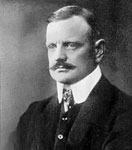Jean Sibelius
(1865-1957)
 In the late 19th century, Jean Sibelius became one of the first composers to utilize authentic Finnish sources to develop a unique musical character for Finland within classical compositions and promote the country’s reputation throughout the musical community. The quintessential romantic composer of his country, his rustic national style is characterized by short repetitive melodic phrases in narrow intervals, unorthodox treatment of triadic harmonies, and strong modal contours based on Finnish folk tunes. Sibelius’s music features these most notably in his epic work: Kullervo. This piece in five movements was inspired by the epic Finnish poem cycle “Kalevala” written by Elias Loennrot, and solidified Sibelius as the truest musical representation of Finnish nationalism.
In the late 19th century, Jean Sibelius became one of the first composers to utilize authentic Finnish sources to develop a unique musical character for Finland within classical compositions and promote the country’s reputation throughout the musical community. The quintessential romantic composer of his country, his rustic national style is characterized by short repetitive melodic phrases in narrow intervals, unorthodox treatment of triadic harmonies, and strong modal contours based on Finnish folk tunes. Sibelius’s music features these most notably in his epic work: Kullervo. This piece in five movements was inspired by the epic Finnish poem cycle “Kalevala” written by Elias Loennrot, and solidified Sibelius as the truest musical representation of Finnish nationalism.
Born Johan Christian Julius Sibelius, he entered the world during a time when Finland was already a grand duchy of governing Russia, but previously had been ruled by Sweden for centuries. Consequently, with Swedish still the official language, there was a large gap between the Swedish-speaking elite and the Finnish-speaking rustic working class who were striving to create a uniquely Finnish culture and encourage independence. From a Swedish-speaking family, Sibelius progressed as a young man through musical study, first performing with his siblings and even studying performance at the Helsinki Music Institute, though he preferred improvisation to disciplined study and his timid temperament continuously found him drawn towards composition. At the institute he became protégé to Martin Wegelius and began composing a number of small chamber works with Nordic influences, including his first nationalistic piece: a set of variations on Finnish folk tunes. In his last year at the institute, he was introduced to the Jaernefel brothers, whose younger sister, Aino, would become his future wife. As supporters of the Finnish nationalist movement, the Jaernefel family promoted the belief that pride in all things Finnish was an essential part of the path to independence from Russia. This political influence led to Aino’s persistent encouragement for Sibelius to compose more Finnish-language pieces.
Sibelius’s own theories about the Finnish musical character were described during his lecture at the University of Helsinki in 1896. The lecture pointed to three main ideas: folk melodies and harmonies were produced from natural instincts developed through immersion in folk culture, the minor pentachord within Finnish folk music provided the most stable harmonic development, and the rune melodies of the Kalevalaic recitation were more complex than previously believed – not repetitive and static, but actually new and original through the individual reciters’ improvisation and personalization. These three ideas drove Sibelius to create his signature style, first seen in Kullervo. It was aggressively modern and filled with anti-traditional aspects and considered strange in comparison to his predecessors, which marked Sibelius’ deviation from the previous generation of composers. His style was characterized by vivid primitivism, personalized treatment of harmony, melody, and orchestral color, as well as musical continuity.
The Kullervo symphonic poem was the strongest submission of a purely Finnish musical work, and one of the composer’s most significant compositions. Continuing to develop the Kalevalaic style, his orchestral works that featured these characteristics have become some of his best known works such as the Lemminkaeinen Suite, the Swan of Tuonela especially, and of course Finlandia. His most significant orchestral works include seven symphonies, one violin concerto, several sets of incidental music and numerous tone poems. Sibelius would refine and perfect these featured musical characteristics, becoming known as the best example of a Finnish nationalist composer. After the war for independence, there was an increase of generous government support for newly thriving arts and musical developments, which perhaps lightened the heart of “Finland’s grand old man.” Though he became musically mute for decades before his death, he was respected throughout his life and is still revered throughout the country and the world for developing a uniquely Finnish style.
Click below to view Jean Sibelius titles:
t7t3l0uhl8|0010C39D6D07|DetailContent|contenttext|62249309-8CC5-48DD-BD9B-9DD59DFD2109
<